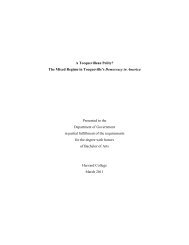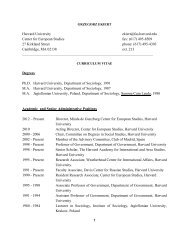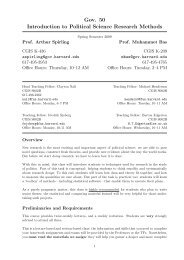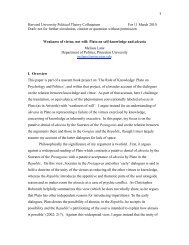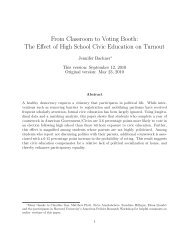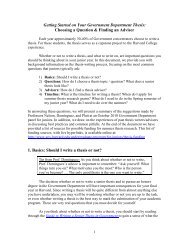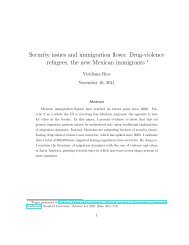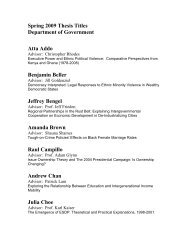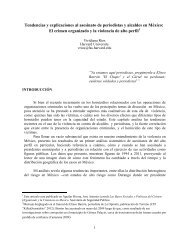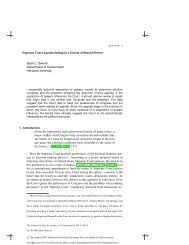Why did Mexico become so violent? - Department of Government ...
Why did Mexico become so violent? - Department of Government ...
Why did Mexico become so violent? - Department of Government ...
You also want an ePaper? Increase the reach of your titles
YUMPU automatically turns print PDFs into web optimized ePapers that Google loves.
Author's per<strong>so</strong>nal copy<br />
Trends Organ Crim (2013) 16:138–155 143<br />
Fig. 3 Self-reinforcing <strong>violent</strong> equilibrium<br />
The mechanism which leads enforcement operations to close the self-enforced<br />
violence loop is simple. When enforcement leads to the capture or assassination <strong>of</strong> an<br />
important trafficker, drug trafficking organizations face two important problems.<br />
First, leadership succession rules within criminal organizations are far from established,<br />
which means an internal battle between drug-trafficking organizations’ potential<br />
succes<strong>so</strong>rs will almost surely ensue. Second, even if succession is not an issue,<br />
recovering the contacts and expertise <strong>of</strong> the captured or dead trafficker in order to<br />
keep the business running can immediately <strong>become</strong> a crucial issue if this information<br />
had not been previously shared with a leader’s potential succes<strong>so</strong>rs. In illegal businesses<br />
where contract enforcement is achieved through informal mechanisms, per<strong>so</strong>nal<br />
relationships play a central role in establishing and maintaining trust between<br />
trade partners. Internal agreements such as corruption pacts and alliances are normally<br />
based on prior per<strong>so</strong>nal ties. Per<strong>so</strong>nal links, long-term relationships, and other<br />
forms <strong>of</strong> <strong>so</strong>cial capital play a crucial role. A new leader may find it difficult to keep<br />
pre-existing agreements in place, which results in reduced pr<strong>of</strong>its and schisms within<br />
the organization.<br />
In the following section, an empirical analysis is presented, supported by case<br />
studies, to test the impact that competition and law enforcement have in the generation<br />
<strong>of</strong> drug-related violence.<br />
Empirical test<br />
To empirically test the contribution that competition and prosecution have in<br />
the generation <strong>of</strong> drug related violence, a simple test is conducted to assess the<br />
relationship that confrontations between trafficking organizations, or between<br />
trafficking organizations and Mexican authorities, have with the number <strong>of</strong><br />
drug-related targeted executions. This test is complemented by narratives from<br />
three case studies in the following section: Michoacán, Guanajuato, and<br />
Guerrero.<br />
The most reliable <strong>of</strong>ficial <strong>so</strong>urce <strong>of</strong> information on drug-related homicides is<br />
<strong>Mexico</strong>’s National Security Council (Consejo de Seguirdad Nacional, CSN), a federal<br />
institution in charge <strong>of</strong> designing security policy within <strong>Mexico</strong>, in operation since



